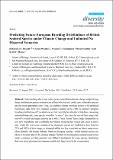Predicting future European breeding distributions of British seabird species under climate change and unlimited/no dispersal scenarios
View/
Date
02/11/2015Author
Funder
Grant ID
Agreement R8-H12-86
Keywords
Metadata
Show full item recordAbstract
Understanding which traits make species vulnerable to climatic change and predicting future distributions permits conservation efforts to be focused on the most vulnerable species and the most appropriate sites. Here, we combine climate envelope models with predicted bioclimatic data from two emission scenarios leading up to 2100, to predict European breeding distributions of 23 seabird species that currently breed in the British Isles. Assuming unlimited dispersal, some species would be “winners” (increase the size of their range), but over 65% would lose range, some by up to 80%. These “losers” have a high vulnerability to low prey availability, and a northerly distribution meaning they would lack space to move into. Under the worst-case scenario of no dispersal, species are predicted to lose between 25% and 100% of their range, so dispersal ability is a key constraint on future range sizes. More globally, the results indicate, based on foraging ecology, which seabird species are likely to be most affected by climatic change. Neither of the emissions scenarios used in this study is extreme, yet they generate very different predictions for some species, illustrating that even small decreases in emissions could yield large benefits for conservation.
Citation
Russell , D J F , Wanless , S , Collingham , Y C , Huntley , B & Hamer , K C 2015 , ' Predicting future European breeding distributions of British seabird species under climate change and unlimited/no dispersal scenarios ' , Diversity , vol. 7 , no. 4 , pp. 342-359 . https://doi.org/10.3390/d7040342
Publication
Diversity
Status
Peer reviewed
ISSN
1424-2818Type
Journal article
Rights
© 2015 by the authors; licensee MDPI, Basel, Switzerland. This article is an open access article distributed under the terms and conditions of the Creative Commons Attribution license (http://creativecommons.org/licenses/by/4.0/).
Description
We thank the European Bird Census Council for their data on European seabird distributions. DJFR was supported by NERC UKPopNet.Collections
Items in the St Andrews Research Repository are protected by copyright, with all rights reserved, unless otherwise indicated.

